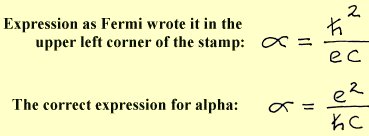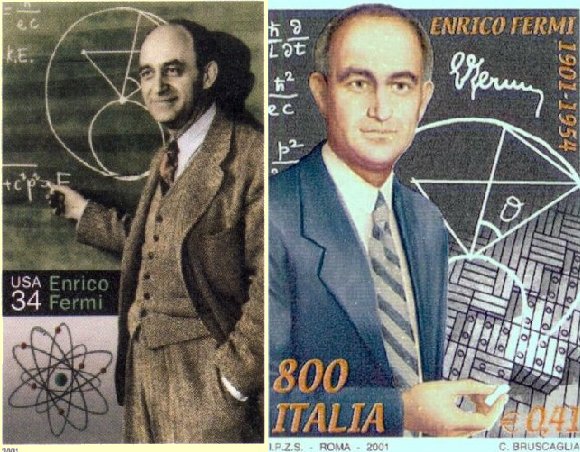The Wrong Formula
Today, Fermi remembers. The University of Houston's College of Engineering presents this series about the machines that make our civilization run, and the people whose ingenuity created them.
In 2001, physicist Greg Huber wrote to Science magazine about the new postage stamp honoring Enrico Fermi. Born in Italy, Fermi was educated at Pisa. Then he worked at Göttingen, Leyden, and Florence, trying to make statistical mechanics consistent with the new quantum physics. He finally created what we call Fermi-Dirac statistics, and he was made a professor at the University of Rome.
In 1938, Fermi won the Nobel Prize for his work. That same year, he left fascist Italy and moved to America. He soon joined the faculty of the University of Chicago. There his work led to the creation of the first energy-producing atomic pile -- activated at the end of 1942.
The picture on the stamp was taken from a photo of Fermi. He's at a blackboard. One formula on the board is the definition of the fine-structure constant from the Schrödinger equation.
That's the sort of near-invisible detail that we take for granted. It's only wallpaper. But Huber put a magnifying glass to it and found it was completely mixed up. Terms were all in the wrong places. It was nonsense, but only to those few who can make sense of such symbols in the first place.

Huber did some detective work. He checked to see if some novice could've filled the blackboard before Fermi entered the room for the photo shoot. But, no, the handwriting perfectly matched the writing in Fermi's notebooks. He'd definitely written it. Maybe he was playing a joke on people. Well, he did have the mind of a trickster, but where was the humor in this? The inescapable conclusion is that Fermi goofed. And we wonder how.
The other day, while I was recording, my producer stopped me:
Capella Tucker: You'd better go back and reread that sentence.
John Lienhard: But -- but, why?
Capella Tucker: Because you said wheat. I think you meant to say seed.
I blinked in amazement; I hadn't heard my own error. The mind does that. It rewrites things. Any good policeman knows how wrong eye-witness testimony can be. Our mind replays a skeletal structure and then adds elaboration. The accuracy of our recollection depends on how rigorously we can control the material we fill in.
So there stood Fermi at the blackboard, thinking about the photographer and putting the right symbols in the wrong places. At his desk with a piece of paper and pencil, Fermi was far better than most -- both at remembering and at filling in the blanks with a finely-woven skein of logic. So I went looking for what Fermi might've said about remembering. Sure enough, the matter was on his mind. In one remark about modern physics, he said,
If I could remember the names of all these particles
I'd be a botanist.
And another remark touched on our constant need to be reminded of the good and familiar things in our lives. Fermi said,
Never underestimate the joy people derive from hearing something they already know.
I'm John Lienhard, at the University of Houston, where we're interested in the way inventive minds work.
(Theme music)
Huber, G., Postage Stamp Poses a Fermi Problem. Science, Vol 294, 5 October, 2001, pg. 53.
For some biographical material, see: Enrico Fermi

Left: the US Fermi stamp in its 34-cent version. Right: An Italian Fermi stamp. The erroneous expression appears in the upper left in both stamps.